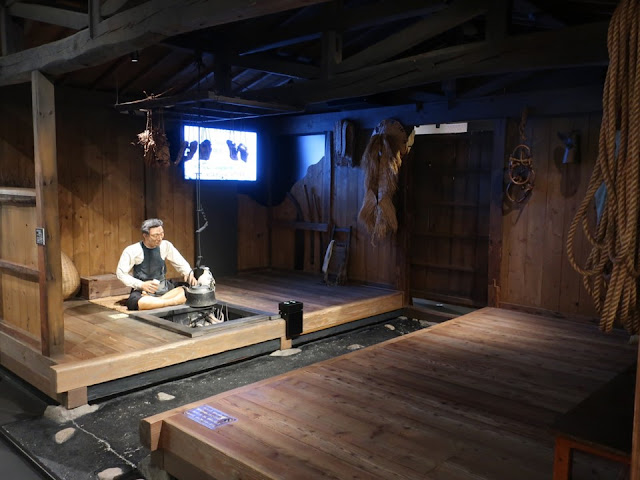Omachi city in central Japan is famous for the gateway of “Tateyama Kurobe Alpine Route”, which is very popular sightseeing route (https://www.alpen-route.com/en/). Omachi is at the foot of high mountains. The museum is specific to mountain life, creatures, geoscience and climbing. We can understand well about former mountain livelihood which is relevant to the theme of this blog.
They live in high and snowy area, so
their livelihood was not easy, although the area flourishes as mountain resort
at present. I could not find their fun thing except for going to hot-spring
in the museum, however, I’m sure there were good side in mountain life.
The museum has an observation room. Unfortunately, it was not a nice view when I visited.
三階の展望室からは北アルプスが見えるのですが、訪問日の展望はイマイチでした。
You can touch stuffed animals in the entrance hall. The antelope (Japanese serow) is fluffy; it could live easily in a cold winter.
玄関ホールになる剥製は触ることができます。カモシカはフカフカで防寒効果抜群です。
Mountains And People、山と人(一階展示室)
Relationship between mountains and people since the prehistoric age are displayed. People have gone to the forest of the mountains for their livelihood such as forestry, hunting and gathering. Or, some have climbed because of mountain worship. In the modern era, people started climbing a summit as hobby.
It is written in the document in 1698 “The high mountain area is dangerous. We don’t know the names of mountains and whose territory it was.” People did not enter the area before the mountain climbing started which was an influence of the western culture.
先史時代から現代までの山と人間の関わり:北アルプスは、林業や狩猟採集などの仕事、又は、信仰のために登る山々でした。明治時代に西洋人によって伝えられた近代登山で、登ること自体が楽しみになりました。
1698(元禄11)年の野口村(現大町市)の文書には、信越国境について、「南の境は槍ヶ岳です。それより南については山名もなく、どなたの領地かも分かりません」と書かれています。北の境も、スバリ岳より先(立山黒部アルペンルートがある場所など)は難所で人が通れず、様子が分からないと書かれています。近代登山が始まる前は、人が出入りする場所ではなかったのです。
The life of a mountain village before 1960s are shown in the center of the exhibition room. Snow covers the village almost half a year.
展示室の中央には、入山口にある集落(野口・大出/おおいで、鹿島)をモデルとして、昭和30年代頃までの生活や生業が展示されています。一年の半分近くも雪がある生活でした。
They took measures against snow and coldness during winter. They enclosed his house with grass such as miscanthus sinensis.
屋敷(家と敷地)には、雪と寒さへの対策が施されました。外壁に茅を立て(冬囲い)、吹雪で家屋が傷むのを防ぎました。
It’s difficult to grow rice plant. They ate mainly wheat and soba buckwheat. As protein source, they ate insects (locusts, wasp larvae). They made pickled vegetables and freeze-dried rice cake as preserved food. Their livelihood wasn’t easy. But, soba buckwheat noodle and traditional wheat cake (oyaki) is popular as specialties; it means those are delicious.
米の収穫が少ないので、蕎麦やおやきを日常食にし、タンパク質源としてイナゴや蜂の子を食べ、冬に備えて漬物や凍り餅を作りました。山で雪国、暮らしは大変だったと思います。でも、蕎麦やおやき、漬物の野沢菜は信州名物として人気です。美味しいということですね。
The major works in mountain were felling and charcoal making. They also dug ore gathered medicinal herbs as earnings.
They needed permissions to go inside forest. The wooden tags in lower right were backcountry permit for woodcutter in the Edo period (1603~1868); those were issued to workers who cut and carried woods for Kaga-han (local government).
山仕事の中心は、木材伐採と炭焼きでした。他にも、鉱物や薬草を採集して収入にしました。
山で仕事をするには許可が要ります。右下は、加賀藩の御用材伐採と搬出作業に従事した信州の木こりの入山札です。
Fishing gear (left) and hunting wear (right) are exhibited. The man in a photo at upper left is the last professional fisherman of Kurobe Gorge. He fished iwana (mountain trout), smoked them and sold them to inns etc. The man in photo at upper right is a hunter named “Bandit in Kurobe”. He shot bear, sold its meat, internal organs an, fur. Some of organs were profitable because those were used as medicine.
漁撈(イワナ釣りの道具/左)と狩猟(毛皮の防寒防水ウエア/右):左上は黒部峡谷の最後の職漁者と曽根原氏。釣ったイワナは、囲炉裏で燻製加工をして、里の旅館などへ売り歩きました。右上は、「黒部の山賊」と噂された猟師のひとり・遠山氏(後ろ姿)。熊などの動物は、肉や内臓を食用にするだけでなく、毛皮を敷物や衣類にし、一部の内臓は生薬として現金収入源になりました。
Mr. Touyama(1851-1920) was a mountain person. He was a hunter and a fisherman. It is said that the exhibits are his belongings.
猟師で釣り師の山人・遠山品右衛門氏(1851-1920)は、山岳ガイドのコーナーで、その衣服や持ち物として伝わる品々とともに紹介されています。
His lunch box (left) and soup container (right) are exhibited. He brought a soup to a mountain. What did he eat?
汁を入れる密閉容器(右)も展示されていました。わざわざ汁物を持って山に入るとは、何を食べたのでしょうね。
“Gift from Kuzu hot-spring resort” is the title of the session. I enlarged the photo of the open-air bath which was taken in the early 20th century.
「葛温泉の恵み」というコーナーです。露天風呂の金壺の湯の写真(大正期)を拡大しました。
The map above shows the hot-spring resort in the mid-19th century. We can know the facilities back then. There were five hot-spring bath houses, four long term accommodations (tenement houses) and a manager’s residence. There were fields. I just guess that they grew vegetables, but they brought rice from other places. Guests probably came even from remote areas. The Buddhist hall was dedicated to Yakushi-nyorai who governs the health.
江戸時代末期に描かれた葛温泉の絵図(官林内宅地拝借願絵図、細かいことですが江戸末期だと御用林だと思います)。湯治場の様子がよく分かります。
温泉場が6カ所、貸し長屋が4棟あり、湯守の居宅もあります。前の写真にあったカナツボの湯も記載されています。畑があるので、野菜は作って、穀物は持ち込んだのでしょうね。湯治客は遠方からも来たのでしょうね。
Praying to The Mountain、山に祈る
Mountains have been sources of livelihood, objects of beliefs and venues of giving thanks to the nature for its gifts.
Stone circle was made around 5500 years ago
which was probably used during a ritual of nature worship. In the ancient and medieval
era, mountain ascetics started training in a mountain; people also started
climbing a mountain for praying. Both practices were influenced by Buddhism.
山は生活の糧を得る場であり、信仰の対象であり、自然の恵みへの感謝の祈りを捧げる場でした。
約5500年前には自然崇拝の祭祀に使われたと思われる環状列石が作られました。古代・中世には、仏教の影響を受け、修験者が修行をし、一般の人々が参詣登山をするようになりました。
People have worshipped "Mountain God" to give thanks for its gifts and to keep safe (right). People also have held rituals of wind protection and rainmaking (prevent from draught). Mountains have been object to pray like deities.
山の恵みと安全を願う山の神信仰。自然災害をないことを願う風除・雨乞い儀礼が行われてきました。
Modern mountain climbing、近代登山
The full-scale model above is a lodge for mountain-climbers in early days (1950s). We can go inside.
In the modern era (after late 19th century), we started trying to conquer high mountain. It is said that it was influenced by western culture. I always have a question about it. Whey did not Japanese people try to climb a summit on which we could enjoy incredible view? However, in reality, only mountain ascetics tried to climb a summit.
初代大沢小屋の実物大モデル(1950年代頃)が展示され、中へ入れます。
近代登山が始まって、人々は山を征服することを目指すようになりましたが、江戸時代・明治時代の人々には、そのような欲望がなかったのか、いつも疑問に思います。景色がよい山頂を目指すのは、修験者たちだけでした。
Exhibits about modern mountain climbing occupy around one third of the room. I don’t mention about them because those are out of scope of my blog. Kindly understand.
展示室の約1/3が近代登山に関する展示でしたが、本ブログのテーマではないので、割愛しますね。
Mountains and those creatures、山の成り立ち・山と生き物(二階展示室)
Stuffed animals which lived in the Japan Alps nearby. The Japanese serow in center was in a small zoo of the museum.
アルプスに住む生物の剥製などが展示されています。中央のニホンカモシカは、博物館の付属動植物園で飼われていた岳子です。
In an attached museum, snow grouses (upper right, special natural monument) are kept.
付属の動植物園です。特別天然記念物の雷鳥(右上)も飼育されています。
I visited again on an ideal day at the end of October. The Japanese Alps are towering.
スッキリ晴れた10月末に行ったときの写真です。北アルプス(爺ガ岳など)の高さが際立ちますね。
Visited in September, 2023
Official website: https://www.omachi-sanpaku.com/ (in
Japanese), accessed in August, 2024
Previous post (museum in the same city which is on the road from Matsumoto to the
Sea of Japan): Omachi
folklore museum、大町市民俗資料館
Next post (museum in the same city which was a merchant house): Chouji-ya (salt road museum)、塩の道 ちょうじや





















Comments
Post a Comment